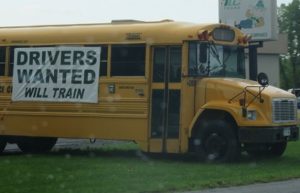- MN ABE Connect
- Archive
- Creating Career Pathways for Adult Learners Within Our Own School Districts
 March 4, 2019
March 4, 2019
Creating Career Pathways for Adult Learners Within Our Own School Districts
Liz Andress, Adult Career Pathways ConsultantMany school districts have employment gaps, and Adult Basic Education has students who can fill those positions. In this article we learn from ABE programs that have established relationships within their districts to build win-win career pathway programs. These pathways include:
- K-12 paraprofessional / teaching assistant
- Early childhood and school-aged child care
- Nutrition service workers
- Bus drivers
- Custodial workers
- … and once employees start in the school districts, opportunities exist for further training and moving up into higher level positions
Career pathways
A career pathway is a combination of rigorous education, training and services that support student persistence and success to enter high-demand jobs with a path to a livable wage. See the ATLAS Adult Career Pathways online resource library for various resources on adult career pathways basics. A common role for ABE is design and delivery of courses that prepare students to pass a credentialing exam or to build knowledge and skills for entry-level employment. In addition, we integrate literacy, numeracy, transitions and digital skills into all career pathway studies to ensure well-equipped employees.
Our own school districts can be great employer partners in developing career pathways for our ABE learners. We share the same overall mission within the district; yet those who do the hiring are often unaware of ABE as a resource.
Effective approaches to working with the district as employer
To begin the conversation, understand the human resource department’s perspective. Their priority is to fill jobs with qualified candidates who will do well and persist in their positions. Many districts also have a goal of diversifying staff (by race, language, ethnicity, gender) to reflect the diversity of and better serve the K-12 student body. So – when approaching the HR department, the message is not “please help our students who need jobs.” Instead, you are offering HR a collaboration that can help them fill their vacant positions with qualified candidates ready to succeed on the job. Benefits to the employer include:
- Access to qualified, diverse job candidates
- Role in shaping curriculum that addresses their needs
- Lower costs of recruitment and training
Example 1: Districts need bus drivers, ABE responds!

Emily Watts, ABE Program Coordinator for Osseo Area Schools, has worked with her HR department for several years on career pathway programs. To start, she says, ask your district:
- What jobs are currently difficult to fill?
- What skill gaps do you find in new or incumbent workers?
- What needs are you projecting for the future?
“Then I lay out for them how ABE can be a partner in filling those employment needs and skill gaps. As I explain what adult career pathways are, describe our students, and what a collaboration could look like with ABE preparing students for success, I watch the light bulbs go on, and creative conversations move forward.” Watts has found many of the materials on employer engagement in the ATLAS resource library extremely helpful in these efforts.
Osseo is building a bus driver career pathway program based on these conversations. ABE provides a class to help students prepare for the commercial driver’s license written exam. Once they get their permit, because the demand for school bus drivers is currently so high, Osseo’s bus contractor First Student will hire them and provide free behind-the-wheel training. ABE makes the direct connection for students with district HR, helps them prepare for the job application and interview process, and provides other supports along the pathway.
The district’s recruitment and retention manager Dante Williams says, “ABE is a fantastic program that yields great results in filling our positions with diverse, qualified candidates.” See a video of Williams sharing his perspective.
Example 2: ABE learners become K-12 paraprofessionals!
 St. Paul ABE started a paraprofessional career pathway program with their school district in Fall 2017. The district identified this as a persistent employment gap and was also keen on recruiting and retaining “paras” from a variety of racial, ethnic and language groups to best serve K-12 students. ABE created a course to prepare students for success on the ParaPro credentialing exam, become familiar with roles of a paraprofessional and build transitions skills for job success. They also created job shadowing / mentoring opportunities for the ABE learners in the schools to see the work first-hand and connect with current paras.
St. Paul ABE started a paraprofessional career pathway program with their school district in Fall 2017. The district identified this as a persistent employment gap and was also keen on recruiting and retaining “paras” from a variety of racial, ethnic and language groups to best serve K-12 students. ABE created a course to prepare students for success on the ParaPro credentialing exam, become familiar with roles of a paraprofessional and build transitions skills for job success. They also created job shadowing / mentoring opportunities for the ABE learners in the schools to see the work first-hand and connect with current paras.
Human resources staff presented to the class and pledged to consider all applications from students who passed the ParaPro exam. After the fall pilot course, ABE and HR worked together to evaluate, and they made improvements to the class that resulted in significantly higher passing and hiring rates in subsequent sessions.
Karen Gerdin, workforce education assistant supervisor at St. Paul ABE, reflected on the first year of the program. “We have learned that for students and the program to succeed, we need a strong ‘navigator’ continually supporting the students and following up with district staff to make sure each step of the process goes well. The collaboration works when we all stay around the table through the challenges, listen to one another, and keep our eyes on the goal of providing qualified ABE learners to fill district positions.”
St. Paul ABE also works with the district’s facilities department to provide CDL permit and low pressure boiler license classes for those employees who would like to advance. Currently ABE is pursuing a new career pathway with the district’s nutrition services, providing food safety licensure training to nutrition service workers.
Resources for work with your district – ATLAS online resource library
Explore ATLAS’s online resources on employer engagement in career pathways.
To gain some basic tools for successfully engaging with an employer like your school district, start with a simple two-hour self-directed online course in the LINCS Learning Portal – it’s on the ATLAS resource page, item second from the bottom, along with a helpful note-taking guide to maximize your learning from the course. Contact Liz Andress at [email protected] if you would like to connect with Minnesota ABE managers or instructors doing some of this innovative work. Good luck!
Newsletter Signup
Get MN ABE Connect—the official source for ABE events, activities, and resources!
Sign UpArticle Categories
- ABE Foundations/Staff Onboarding
- ACES/Transitions
- Adult Career Pathways
- Assessment
- CCR Standards
- Citizenship
- COVID-19
- Cultural Competency
- Digital Literacy/Northstar
- Disabilities
- Distance Learning/Education
- ELA
- Equity/Inclusion
- ESL
- HSE/Adult Diploma
- Listening
- Math/Numeracy
- Mental Health
- Minnesota ABE
- One-Room Schoolhouse/Multilevel
- Professional Development
- Program Management
- Reading
- Remote Instruction
- Science
- Social Studies
- Speaking/Conversation
- Support Services
- Teaching Strategies
- Technology
- Uncategorized
- Volunteers/Tutors
- Writing